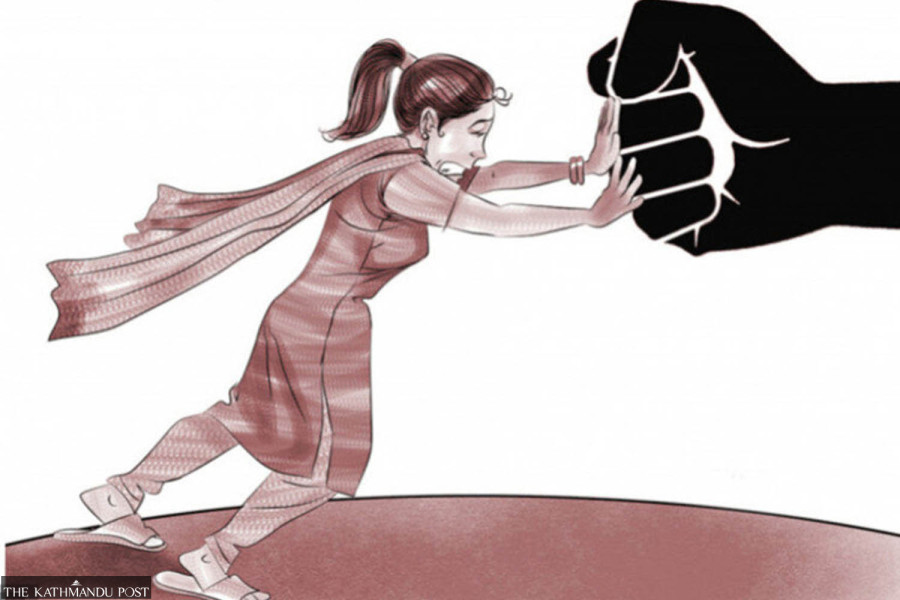National
Children at high risk of online sexual abuse, exploitation
There’s been a steady rise in online harassment of minors, especially after the pandemic.
Aarati Ray
Parwati, a bright and social 15-year-old from Lalitpur, enjoyed connecting with friends and meeting new people through social media. But from last year, Parwati, who the Post is identifying with a pseudonym, hasn’t been the same as a result of online grooming and sexual abuse.
“Our bubbly girl is no longer so,” said Parwati’s mother. “Although she is taking counselling, she is still soulless.”
When she was 14, Parwati got a message from someone posing as a popular teen influencer. He complimented her on her photos and suggested she join an exclusive online group for aspiring models. Flattered by the attention, Parwati began talking to him daily.
He gradually coaxed her into sharing private photos, promising that they would stay between them and assuring her that she was special.
Slowly, Parwati became withdrawn, spending long hours on her phone and becoming unusually secretive. Her parents dismissed it as typical mood swings that teenagers go through.
“If only we hadn’t noticed sooner, things wouldn’t have turned out this way,” says Parwati’s mother.
Parwati, too scared to tell them, kept everything to herself, believing she could manage it on her own.
It wasn’t until an explicit image of Parwati was leaked online in her school group that her parents finally understood the gravity of the situation. By then, the damage had been done—Parwati had been a victim of grooming and blackmail for nearly a year.
Parwati’s experience shows how vulnerable online spaces are for children, who the UN Convention on the Rights of the Child defines as a person below the age of 18.
Parwati’s case is not isolated.
A research conducted by Voice of Children and KNH Germany in 2023 involving 514 children, families and child protection and juvenile justice stakeholders in Koshi and Bagmati provinces revealed concerning forms of OCSA (Online Child Sexual Abuse).
Among the girls in the study, 38.6 percent reported receiving sexual calls and messages, 34.1 percent received inappropriate photos, 13.7 percent encountered indecent links, videos, or images, 6.8 percent were unaware of such occurrences, and 6.8 percent faced other forms of online harassment and exploitation.
Among boys, 32.3 percent reported receiving sexual calls and messages, 29.2 percent were sent indecent photos, 15.4 percent received inappropriate links, 16.9 percent were unaware, and 6.2 percent experienced other forms of abuse and exploitation online.
The growing incidents of various forms of online child sexual abuse and exploitation is further buttressed by data from the Cyber Bureau.
In just under two months of the fiscal year 2024-25, the bureau has recorded 68 cases of cybercrimes involving children, including online sexual abuse.
In fiscal year 2023-24, the bureau recorded 635 cases of cyber violence involving children, up from 176 cases in fiscal year 2022-23—for a 260.8 percent rise.
Experts say while Nepal has made efforts to address online child sexual abuse, existing laws and frameworks are not being enforced due to limited resources, lack of awareness, and inadequate training.
Moreover, parents, caregivers, and children are often unaware of the risks of online abuse, making the current legal framework insufficient to fully address the issue.
The recent rise in cybercrime cases involving children can be traced back to the Covid lockdown, when digital platforms became essential for children’s daily education.
However, according to Roshani Poudyal, an assistant professor of law at Tribhuvan University and researcher in digital safety, the real issue was lack of proper monitoring of children’s online activities, leaving them exposed to various dangers.
“Parents and teachers haven’t done enough on addressing risks online,” Poudyal says.
Cyber violence against children is not specific to Nepal—it’s a global problem.
At the 28th session of the Human Rights Council in 2015, a report highlighted how new technologies, while offering opportunities, also increase children’s vulnerability to online sexual exploitation.
Contrary to the general narrative, while it may seem that only girls are affected by OCSA, boys too are vulnerable, says Poudyal.
A 2019 study conducted in the Philippines found that all children, regardless of gender, are at risk online; “boys seeking sexual identity support or accessing pornography are especially vulnerable,” the report said.
The huge gap in reporting of online abuse is a problem, as per the research of Voice of Children. Parents hesitate to report such cases due to social stigma, and children often don’t realise they’re being abused.
“For example, if someone comments on their picture saying, ‘You’re so beautiful’ or ‘You’re so sexy,’ children might take it as a compliment, unaware of its inappropriate nature, especially if a predator is involved,” Poudyal says.
Even if they recognise the abuse, children hesitate to tell their parents. This fear of blame or dismissal usually keeps children silent.
The cases of OCSA often being dismissed and unreported adds to the gravity of the issue as, in such cases, there is a higher chance of the impact of OCSA on children going unaddressed, as happened with Parwati who faced continuous abuse for a year.
Parwati is still struggling from PTSD and depression, showing how the psychological toll of OCSA can be as severe as offline abuse. The victims often experience self-blame, depression, nightmares, suicidal thoughts and anxiety.
Raju Ghimire, deputy director of Voice of the Children, points out that while Nepal has several relevant policies, they are fragmented and lack a dedicated focus on OCSA prevention.
The Electronic Transaction Act, 2008 prohibits the dissemination of illicit content online but is insufficient to address online child sexual abuse. These include time limits for filing complaints (35 days), privacy concerns, fair trial issues, and inadequate child protection measures.
Even the Act Relating to Children, 2018 fails to define key terms such as child pornography, grooming, sextortion, or cyberstalking, contributing to poor understanding among stakeholders.
“The Act is also silent on how to handle cases where the abusers are parents or guardians, and it lacks provisions for alternative shelters for minor victims when family members are perpetrators,” Ghimire says.
Not only is there a paucity of special protections for vulnerable groups like children with disabilities or those in the LGBTQIA+ community, the existing act related to children does not address cross-border online child sexual abuse which needs to be covered either by the Act Relating to Children or the Telecommunication Act, 1997.
Ghimire says there should be a comprehensive umbrella act with specific provisions addressing OCSA. “This act should define and incorporate various issues related to OCSA,” he says. “There should be a consultative process to amend the Act Relating to Children, 2018 to better cover OCSA.”
Ghimire also recommends including a child psychologist in the complaint registration and hearings process to ensure proper support.
“The digital world is complex,” Poudyal says. “It is vital for parents, children, and everyone to be sensitised about online sexual abuse and cyberbullying.”
She adds that prevention should be prioritised over legal protection after the abuse. She calls for a specific legal framework to improve reporting, response, and investigation mechanisms. “We need better monitoring and regulation of ISPs, clear definitions of various forms of online child abuse, and enhanced digital literacy for children, parents, teachers, and the general public,” she said.
“Many people are unaware of what constitutes online sexual abuse or how to address it legally. Awareness programmes in schools and homes are a must. After all, these places are where children spend most of their time.”




 22.12°C Kathmandu
22.12°C Kathmandu














